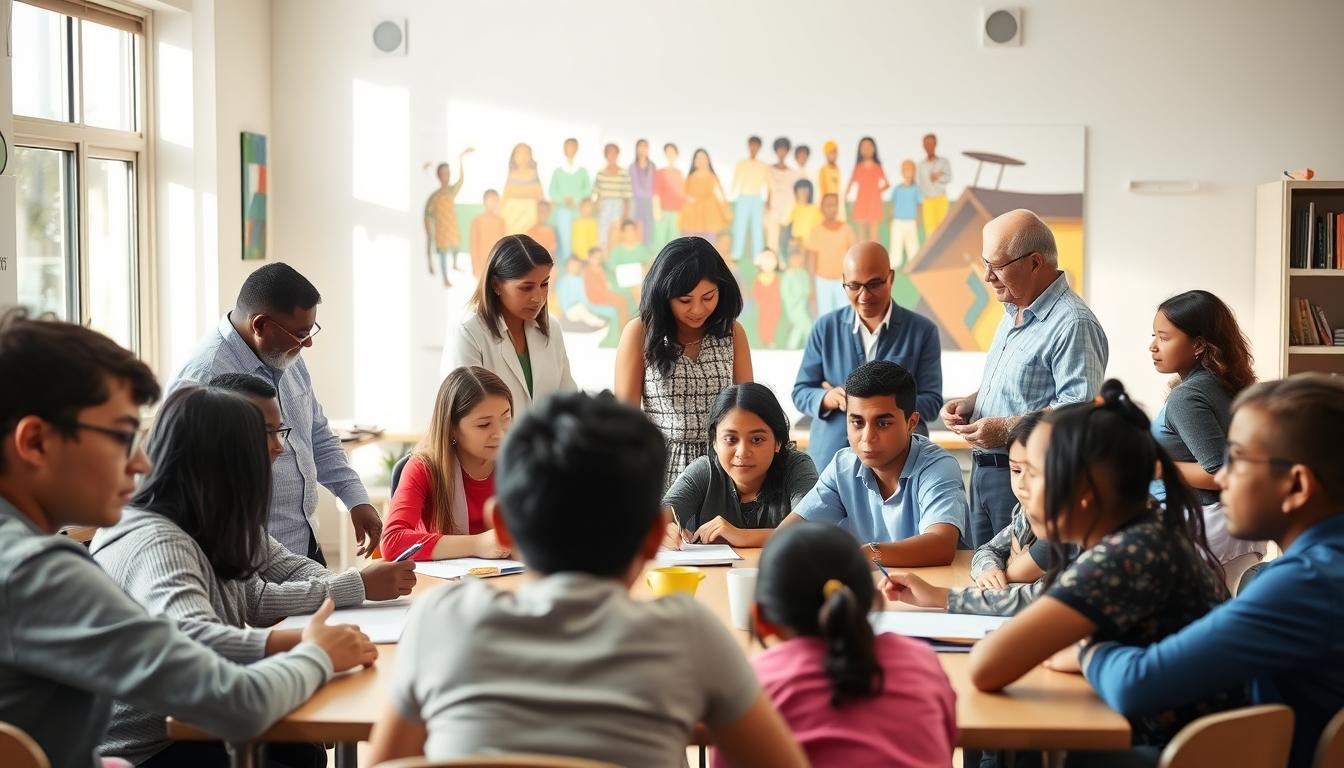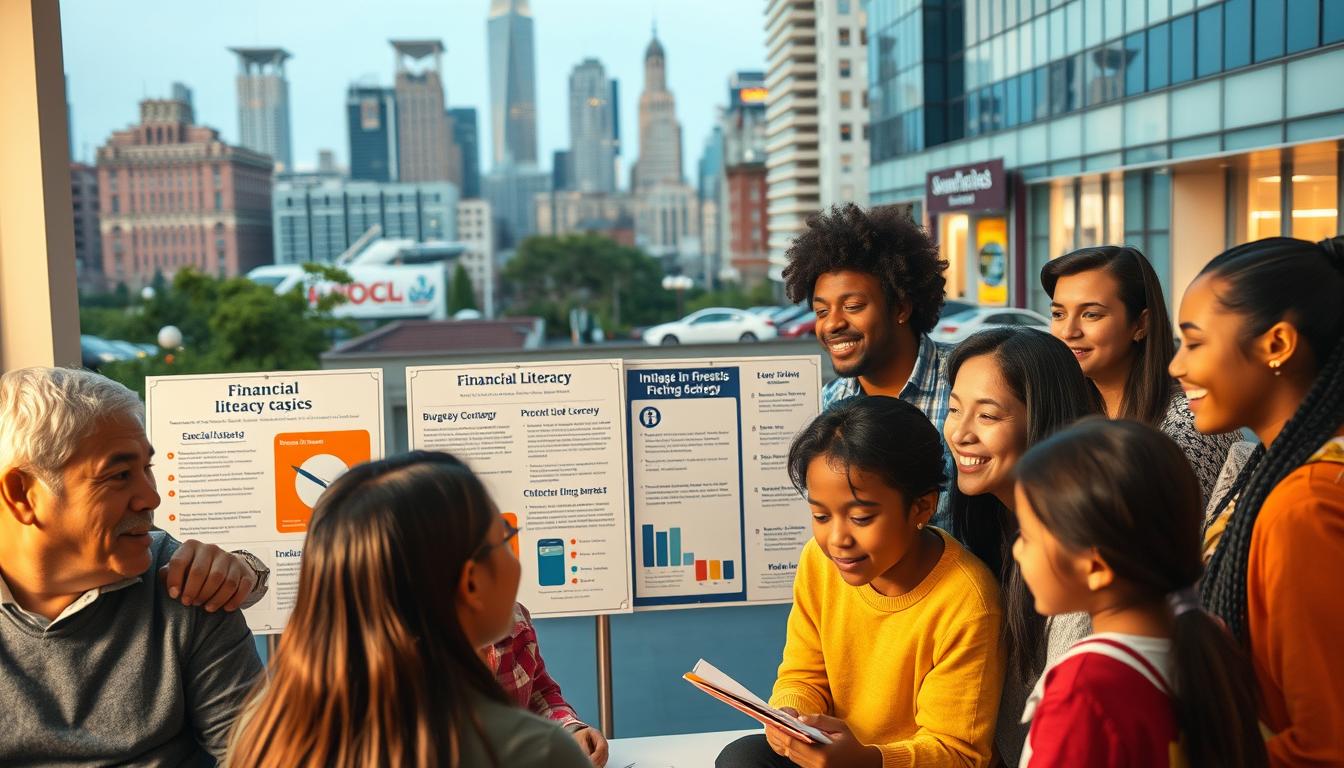Advancing Digital Literacy: Equipping Immigrants with Essential Tech Skills
The world is getting more connected through technology. Digital literacy is now key for immigrants to succeed in their new home. It helps them do everyday tasks and join the workforce and community better.
This article highlights the importance of digital skills for immigrants. It shows how technology proficiency helps them fully participate in society.
By teaching immigrants essential tech skills, we can make society more inclusive. It’s important to understand and tackle the challenges of digital literacy. This will help create educational programs that work for immigrants in the U.S.
Introduction to Digital Literacy for Immigrants
Digital literacy is about knowing how to use digital tools and platforms. For immigrants, learning these skills is key to fitting in. It helps them understand and use digital tools for communication and more.
As the world gets more connected, knowing how to use technology is important. It opens doors for personal and professional growth. It also helps immigrants feel included in their new communities.
Understanding Digital Literacy
Digital literacy means knowing how to find, check, and use digital information. It’s a mix of computer skills and online abilities. These skills help immigrants find and use online resources, like education and community services.
Being tech-savvy helps immigrants overcome challenges. It makes it easier for them to connect with others and find jobs. This way, they can integrate into their new society more easily.
Importance of Digital Skills in Everyday Life
In today’s world, having basic online skills is essential. Tasks like banking, job hunting, and getting government services rely on technology. For immigrants, knowing how to use technology can greatly improve their life.
By learning these skills, immigrants can better understand their new surroundings. They can connect with others and find jobs they couldn’t before. This makes a big difference in their daily lives.
The Current Landscape of Digital Literacy in the U.S.
Digital literacy among immigrants in the U.S. shows both challenges and opportunities. Many immigrants face barriers in getting technology access. It’s key to look at their current situation and the trends in digital education.
Statistics on Immigrant Access to Technology
Research points out a gap in technology access for immigrants compared to native citizens. Only 58% of immigrants have reliable internet. This gap affects their digital skills, making internet literacy a critical area for improvement.
Trends in Digital Education for Immigrants
Initiatives are emerging to address these challenges. Programs aim to improve computer skills and internet use. Trends show that blended learning models are effective, combining online and community training.
This approach not only closes the digital divide but also builds community. Learners share experiences and knowledge, fostering a sense of belonging.
Barriers to Digital Literacy Among Immigrants
Immigrants face many barriers to digital literacy. These barriers make it hard for them to use technology and find resources. Language and socioeconomic issues are two big challenges that stop them from learning digital skills.
Language and Communication Challenges
Language barriers are a big problem for digital literacy. Many tech materials aren’t in immigrants’ native languages. This makes it hard for them to understand and learn.
They might feel too scared or unsure to try to learn. Also, they can’t join in training programs because of language issues. Good communication is key to learning new skills.
Socioeconomic Factors Impacting Access
Socioeconomic issues also affect immigrants’ access to technology. Money problems stop them from getting the devices and internet they need. They often spend what little money they have on basic needs, not tech.
This limits their education and job chances. These issues make it tough for immigrants to get the digital skills they need.
The Role of Community Organizations
Community organizations are key in helping immigrants learn digital skills. They run programs that meet the needs of immigrant groups. These efforts help people improve their digital abilities, opening up new chances for them.
Programs Focused on Digital Literacy
Many community groups offer digital literacy programs. These programs teach skills that are useful in daily life. They include:
- Basic computer skills training
- Access to technology and the internet
- Workshops on navigating online resources
- Classes aimed at improving digital communication
These programs work with community centers, libraries, and schools. This ensures immigrants get the support they need, tailored to their situations.
Success Stories from Various Communities
Many people have changed their lives thanks to community support. Their stories show how digital literacy programs make a difference:
- A single mother found a job after learning digital skills. This helped her support her family.
- An immigrant elder learned to use email and social media. Now she stays in touch with loved ones worldwide.
- A group of young adults started a tech business. They were inspired by skills they learned in community workshops.
These stories underline the vital role of community organizations. They support immigrants through digital literacy programs.
Educational Resources for Immigrants
Access to good educational resources helps immigrants learn digital skills. There are many options, from online platforms to community workshops. These help people get the tech skills they need.
Online Platforms for Learning Digital Skills
Many online learning platforms have come up in recent years. They offer flexibility, letting users learn at their own speed. Courses cover everything from basic computer skills to advanced digital tools. Some top resources include:
- Coursera: Offers courses from universities and organizations, covering digital skills.
- Udacity: Focuses on tech skills, with hands-on projects to improve knowledge.
- Khan Academy: Provides free courses to boost digital skills.
Local Workshops and Training Sessions
For hands-on learning, digital skills workshops are great. Local groups often run sessions for immigrants. These workshops offer:
- Hands-on activities to reinforce learning.
- Chances to meet others and find mentors.
- Supportive environments that help with language and cultural differences.
Tailoring Digital Literacy Programs
Creating digital literacy programs that fit immigrant needs is key. Knowing what immigrants want to achieve helps make learning better. It means teaching in ways that work for everyone, no matter their background.
Understanding Immigrant Needs and Goals
Every immigrant has their own story, hopes, and hurdles. Programs that meet these needs work much better. They focus on skills that help people reach their goals.
Learning what drives each person makes lessons more meaningful. This approach creates a supportive space for everyone.
Incorporating Cultural Context in Teaching
Teaching that respects cultural backgrounds boosts learning. It makes lessons more relatable and engaging. This approach helps everyone understand better.
Using different teaching methods helps students remember more. Studies show that lessons that fit the culture help learners stay motivated. This makes the learning journey more rewarding.
Collaboration with Tech Companies
Working together, community groups and tech companies help people who don’t have much access to technology. They share resources to make sure everyone can learn about digital skills. This way, they can offer lessons that really meet the needs of newcomers.
Partnerships for Providing Resources
Partnerships with tech giants like Google and Microsoft are key to better digital skills. They bring in training materials and tools. This lets groups offer:
- Access to the latest tech and platforms.
- Workshops and training on digital skills.
- Help in making curricula that fit specific communities.
Important Initiatives and Grants
Grants for digital literacy projects come from partnerships between non-profits and tech companies. These grants support new ways to teach digital skills. They focus on:
- Funding for local workshops and training.
- Help for schools to include digital literacy in their lessons.
- Tools to help overcome language barriers in tech education.
The Importance of Basic Computer Skills
Basic computer skills are key to being digitally competent. Immigrants face many challenges when adapting to new tech. It’s vital to learn about operating systems and how to use the internet safely. These skills boost confidence and independence in both personal and work life.
Familiarity with Operating Systems
Knowing different operating systems is crucial for using technology well. Systems like Windows, macOS, and Linux have their own ways of working. Learning about these helps users:
- Do basic tasks like managing files and installing software.
- Use apps that make work easier.
- Fix small tech problems on their own.
Navigating the Internet Safely
Staying safe online is very important, especially for newcomers. Learning about safe online habits protects against cyber threats. Important internet safety tips include:
- Spotting phishing scams and harmful links.
- Using strong, unique passwords.
- Setting privacy options right on social media.
Advanced Digital Skills for Employment
In today’s job market, having advanced digital skills is key. Employers want people who can use different software and know how to use social media well. These skills make you more attractive to employers and can help you move up in your career.
Essential Software Proficiencies
Knowing how to use various software is important. You should be familiar with Microsoft Office, Adobe Creative Cloud, and CRM software. Also, knowing how to use data analysis and project management tools can help you get hired.
Being good with these programs helps you do your job better. It also helps your team succeed.
Networking and Social Media Skills
Using social media is now a must-have skill. Sites like LinkedIn, Twitter, and Facebook are great for networking and building your brand. A strong online presence can lead to job offers.
Knowing how to use social media well lets you share your knowledge. It helps you show your skills and goals to others in your field.
Measuring the Impact of Digital Literacy
Measuring the success of digital literacy programs is key. It’s about seeing real results. By setting clear goals, we can see if people are learning and using what they learn.
These goals help us know if our programs are working. They guide us to make things better and get better results.
Metrics for Success in Programs
There are important metrics to check if digital literacy programs are doing well. Looking at participant engagement is crucial. It shows if people are really learning.
Here are some key things to track:
- Skill improvement rates after training
- How many people show up to workshops
- How many stick with the program
- How many finish courses
These help us see where we need to improve. They help us make our programs better.
Anecdotal Evidence from Participants
While numbers are important, hearing from participants is even more powerful. Their stories show how digital skills help in real life. They talk about things like:
- Finding jobs
- Keeping in touch with family far away
- Getting online services they need
These stories make our programs more believable and valuable. Using both numbers and stories helps us truly understand how well our programs work.
Future Trends in Digital Literacy Education
The world of digital skills education is changing fast thanks to technology. AI is playing a big role in making learning better for people from all walks of life. These new tools help make learning easier and more tailored to each person, including immigrants who want to get better at using technology.
Emergence of AI and Tech Innovations
AI is changing how we teach and learn digital skills. Learning platforms now use smart algorithms to see how well you’re doing and give you content that fits you. This means you can learn at your own speed.
Also, virtual tutors and chatbots are always there to help. They fill the gap left by old-school teaching methods.
The Shift Towards Remote Learning Models
Remote learning is becoming a big deal in digital literacy education. Schools around the world are moving online because of global events. This change is both a challenge and an opportunity for immigrants wanting to improve their tech skills.
With remote learning, students can learn from anywhere. They can find great resources and talk to experts without being in the same place.
Conclusion: The Path Forward for Immigrants
Improving digital skills for immigrants is key to better integration and more opportunities. It helps them fit into today’s fast-paced world. With the right digital skills, immigrants can find jobs, connect with others, and handle daily tasks.
Building a Digital Future Together
Working together is crucial for immigrant digital education. Community groups, tech companies, and governments must join forces. This way, everyone gets the help they need, making society more inclusive and tech-savvy.
Call to Action for Stakeholders
It’s time for everyone to help with digital literacy. Investing in education and training is essential. Together, we can build a better digital future for immigrants, leading to success for all.
FAQ
What is digital literacy?
Why is digital literacy important for immigrants?
What barriers do immigrants face in achieving digital literacy?
How can community organizations support digital literacy among immigrants?
What online resources are available for improving digital skills?
How can digital literacy programs be tailored to meet immigrant needs?
What role do tech companies play in advancing digital literacy?
Why are basic computer skills foundational to digital literacy?
What advanced digital skills are beneficial for employment?
How can the impact of digital literacy programs be measured?
What future trends in digital literacy education should be expected?
Published on: 28 de March de 2025

Luke Martin
Luke Martin, author of Credwallets.com, is a mathematics graduate with a specialization in financial markets. Known for his love of pets and his passion for sharing knowledge, Luke created the site to provide valuable insights into the complexities of the financial world. His approachable style and dedication to helping others make informed financial decisions make his work accessible to all, whether they're new to finance or seasoned investors.







